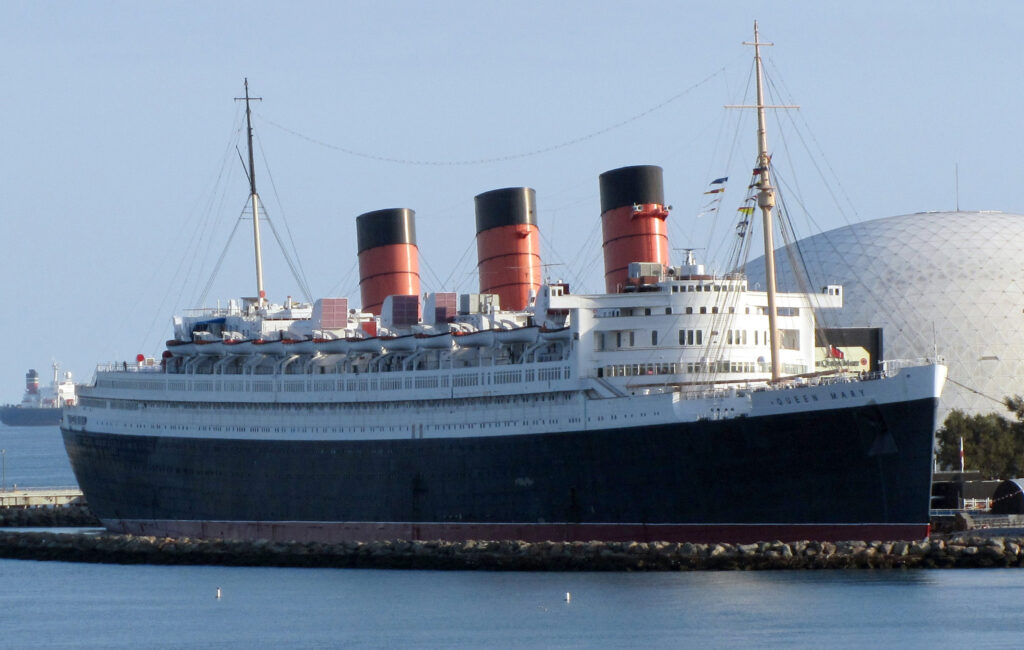Of the 35 Atlantic liners to hold the Blue Riband, 25 were British. Thirteen were Cunard ships and the RMS Queen Mary which was jointly a Cunard-White Star ship. The two companies joined in 1934 because of the great depression. It was a period when many cruise lines combined. In 1932 Mussolini formed NGI which was a merger of three Italian Cruise lines because he wanted to see his ship be the best and win the Blue Riband. The 2004 Queen Mary 2 is an Ocean Liner and maybe the only one at sea. Certainly, one of the few with a sixteen-piece orchestra occasionally on stage and the style of those forgotten ships.

The era of the passenger liner crossing the Atlantic Ocean is not over, but it is different. When the ocean liners were in their hay day, they were the largest, most special ships. They ran passengers on the Westbound route, from Europe across the Atlantic to America. That was considered to be the more difficult direction. It was against the Gulf Stream and the prevailing weather systems. However, it was the most important direction as it was a time of mass migration, of Jews escaping.
To have the biggest fastest ship was something a nation wanted and subsided. The new TV show Lost Liners is a real history lesson on how important these were and how they were converted to be troop ships. I recently had the pleasure of being a lecturer on the program with Dr Helen Doe, a contributor to that program. A fascinating woman with so much knowledge to share.
One difference is that the ocean liners were narrow, slick, and built for speed whereas the modern cruise ship is wider.
Like the four-minute mile, the four-day crossing was a record to break. It was broken going west by the French ship the Normandie in 1937. The trip spread from the 29th of July to the 2nd of August. She had failed on her previous attempts. Her official time was 3 days, 23 hours and just 2 minutes. The RMS Queen Mary beat that the year later with a time of 3 days 21 hours 48 minutes in a speed just a fraction under 31 knots. The final ship listed is the SS United States in 1952 with a time of 3 days 12 hours and 12 minutes. That was an average speed of 31.51 knots.
Interesting that all three left the Cornish iron lighthouse at Bishop Rock in the westernmost part of the Isles of Scilly and were timed to a lightship located at 40.46°N 73.83°W. The Ambrose Light, often called Ambrose Tower, was at the convergence of shipping lanes in Lower New York Bay. Although the lightship was there to guide ships, a tanker hit it on November 3, 2007. That was her final nail in the hull, and she was dismantled.
The Eastbound route is an interesting one for us, cruisers, because ships sailed back empty until they were sold with the idea of tourism. Successful immigrants started to travel home to see relatives in Italy and other parts of the UK. The Queen Mary broke the 4-day time in 1936 with a time of 3 days 23 hours and 57 minutes. She swapped the accolade with the Normandie and held it until 1952 when the SS United States took it.
The term Blue Riband comes from horse racing and although the time taken to cross is key, it is actually the average speed which is the currency of the unofficial award. In 1935 Harold K. Hales donated his Hales Trophy for a very similar event with slightly different rules. However, the Blue Riband remains the one that is remembered and mentioned, and it is considered that it is still held by the SS United States as no other passenger service has beaten its times or speed. The SS United States was completely stripped by 1994 and then towed to Pier 82 on the Delaware River, in Philadelphia, where she remains today.
Our Cunard Chat Group is on… Cunard Facebook Group

